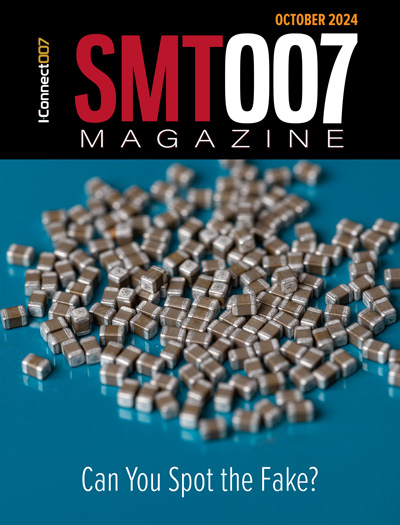-

- News
- Books
Featured Books
- smt007 Magazine
Latest Issues
Current Issue
Counterfeit Concerns
The distribution of counterfeit parts has become much more sophisticated in the past decade, and there's no reason to believe that trend is going to be stopping any time soon. What might crop up in the near future?

Solder Printing
In this issue, we turn a discerning eye to solder paste printing. As apertures shrink, and the requirement for multiple thicknesses of paste on the same board becomes more commonplace, consistently and accurately applying paste becomes ever more challenging.

A Culture of Thriving
One cannot simply command thriving; it must be nurtured, developed, and encouraged. In this issue, we explore strategies to improve your working relationship model—both internally and externally. In this culture of thriving, your business will grow in the process.
- Articles
- Columns
Search Console
- Links
- Media kit
||| MENU - smt007 Magazine
Intel, Ohio Supercomputer Center Double AI Processing Power with New HPC Cluster
February 20, 2024 | Intel CorporationEstimated reading time: 2 minutes
A collaboration including Intel, Dell Technologies, Nvidia and the Ohio Supercomputer Center (OSC), introduces Cardinal, a cutting-edge high-performance computing (HPC) cluster. Purpose-built to meet the increasing demand for HPC resources in Ohio across research, education and industry innovation, particularly in artificial intelligence (AI).
AI and machine learning are integral tools in scientific, engineering and biomedical fields for solving complex research inquiries. As these technologies continue to demonstrate efficacy, academic domains such as agricultural sciences, architecture and social studies are embracing their potential.
Cardinal is equipped with the hardware capable of meeting the demands of expanding AI workloads. In both capabilities and capacity, the new cluster will be a substantial upgrade from the system it will replace, the Owens Cluster launched in 2016.
The Cardinal Cluster is a heterogeneous system featuring Dell PowerEdge servers and the Intel® Xeon® CPU Max Series with high bandwidth memory (HBM) as the foundation to efficiently manage memory-bound HPC and AI workloads while fostering programmability, portability and ecosystem adoption. The system will have:
- 756 Max Series CPU 9470 processors, which will provide 39,312 total CPU cores.
- 128 gigabytes (GB) HBM2e and 512 GB of DDR5 memory per node.
With a single software stack and traditional programming models on the x86 base, the cluster will more than double OSC’s capabilities while addressing broadening use cases and allowing for easy adoption and deployment.
The system is also equipped with:
- Thirty-two nodes that will have 104 cores, 1 terabyte (TB) of memory and four Nvidia Hopper architecture-based H100 Tensor Core GPUs with 94 GB HBM2e memory interconnected by four NVLink connections.
- Nvidia Quantum-2 InfiniBand, which provides 400 gigabits per second (Gbps) of networking performance with low latency to deliver 500 petaflops of peak AI performance (FP8 Tensor Core, with sparsity) for large AI-driven scientific applications.
- Sixteen nodes that will have 104 cores, 128 GB HBM2e and 2 TB DDR5 memory for large symmetric multiprocessing (SMP) style jobs.
“The Intel Xeon CPU Max Series is an optimal choice for developing and implementing HPC and AI workloads, leveraging the most widely adopted AI frameworks and libraries,” said Ogi Brkic, vice president and general manager of Data Center AI Solutions product line at Intel. “The inherent heterogeneity of this system will empower OSC’s engineers, researchers and scientists, enabling them to fully exploit the doubled memory bandwidth performance it offers. We take pride in supporting OSC and our ecosystem with solutions that significantly expedite the analysis of existing and future data for their targeted focus areas.”
Suggested Items
Spot Market for Memory Struggles in First Half of 2024; Price Challenges Loom in Second Half
08/30/2024 | TrendForceTrendForce reports that memory module makers have been aggressively increasing their DRAM inventories since 3Q23, with inventory levels rising to 11–17 weeks by 2Q24.
Global Semiconductor Manufacturing Industry Strengthens in Q2 2024
08/19/2024 | SEMIThe global semiconductor manufacturing industry in the second quarter of 2024 continued to show signs of improvement with significant growth of IC sales, stabilizing capital expenditure, and an increase in installed wafer fab capacity, SEMI announced in its Q2 2024 publication of the Semiconductor Manufacturing Monitor (SMM) Report, prepared in partnership with TechInsights.
Micron Develops Industry’s First PCIe Gen6 Data Center SSD for Ecosystem Enablement
08/07/2024 | MicronFMS: The Future of Memory and Storage — Micron Technology, Inc., announced it is the first to develop PCIe® Gen6 data center SSD technology for ecosystem enablement as part of a portfolio of memory and storage products to support the broad demand for AI.
Memory Makers Drive Semiconductor Market Growth in Q1 2024 as AI Demand Soars
08/07/2024 | IDCLatest research from IDC, titled Worldwide Semiconductor Integrated Device Manufacturing Market: Top 10 Vendor Ranking and Insight, 1Q24, reveals significant trends in the semiconductor industry during the first quarter of 2024.
AI Drives Substrate Market Back to Growth; Global Market Size Expected to Reach $15.32 Billion in 2024
07/29/2024 | TPCAUnder the impetus of emerging applications such as electric vehicles, AI, and high-performance computing, the semiconductor industry is currently experiencing rapid growth.


